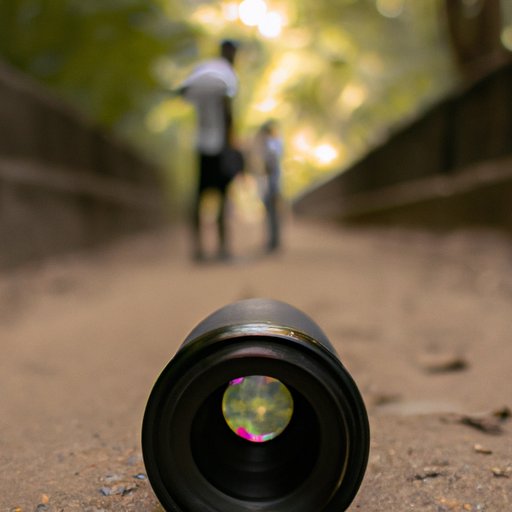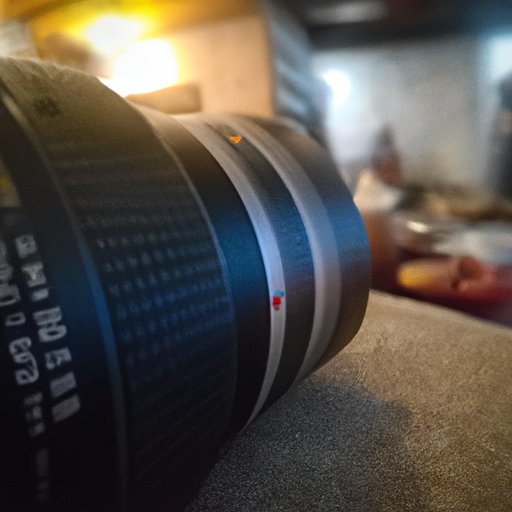Introduction
Focus plays an important role in photography. It can determine the success or failure of a shot, as it affects image clarity and quality. Yet, many photographers don’t fully understand how to achieve the right focus in their shots. In this article, we’ll explore what focus is, why it’s important, and how you can use it to create stunning images.
Analyzing the Role of Focus in Photography
Before we dive into different types of focus and how to achieve them, let’s take a look at what focus actually is and why it matters in photography.
What is Focus?
Focus refers to the sharpness of an image. A focused image appears clear and crisp, while an unfocused image will appear blurry and out of focus. When an image is in focus, the light that passes through the lens hits the sensor, creating a clear and defined image. When an image is out of focus, the light scatters, resulting in a blurred and distorted image.
Reasons for Focusing
Focusing in photography is important for several reasons. First, it helps create a more aesthetically pleasing image. A well-focused image will have greater depth and texture, making it more visually appealing. Second, focusing helps create a sharper image, which is especially important when shooting with a shallow depth of field. Finally, focusing allows you to draw attention to certain elements in the frame, such as a person or object, and make them stand out from the rest of the scene.
Different Types of Focus
There are three main types of focus used in photography: autofocus, manual focus, and hyperfocal distance. Let’s take a closer look at each one.
Exploring Different Types of Focus in Photography
Autofocus
Autofocus is the most common type of focus used in photography. It uses sensors to detect the subject and automatically adjust the focus accordingly. Autofocus is quick and easy to use, and it’s the best option for shooting fast-moving subjects. However, it’s not always accurate and can be unreliable in low-light situations.
Manual Focus
Manual focus requires you to manually adjust the focus ring on your lens. It gives you more control over the focus of your shots and allows you to fine-tune the focus for maximum accuracy. Manual focus is great for shooting static subjects, but it can be time-consuming and difficult to use for fast-moving subjects.
Hyperfocal Distance
Hyperfocal distance is a type of focus used to maximize the depth of field in a photo. By setting the focus to a specific distance, you can ensure that the entire scene is in focus, from the foreground to the background. This is useful for landscape and architectural photography, as it allows you to capture an entire scene in sharp detail.

Understanding How to Achieve Focused Shots in Photos
Now that you know the different types of focus, let’s take a look at how to achieve focused shots in photos. There are three main settings that you’ll need to adjust to get the right focus: aperture, shutter speed, and tripod.
Adjusting Aperture
The aperture is the opening in the lens that determines how much light enters the camera. The size of the aperture also affects the depth of field in a photo. By using a larger aperture, you can create a shallow depth of field, which will help separate the subject from the background and make it stand out. Conversely, using a smaller aperture will help increase the depth of field, allowing you to capture a larger area in sharp focus.
Setting the Right Shutter Speed
The shutter speed is the amount of time the shutter is open, which determines how much light enters the camera. A slow shutter speed will allow more light to enter the camera, which can help you achieve a better exposure. However, a slow shutter speed can also cause motion blur, so it’s important to find the right balance between shutter speed and exposure.
Using a Tripod
A tripod is an essential tool for achieving sharp images. It helps keep the camera still, which is essential for achieving a sharp focus. A tripod also allows you to use slower shutter speeds without worrying about camera shake, which can help you capture sharper images in low-light situations.

Tips for Achieving Perfect Focus in Photography
Now that you know how to set the right settings for focus, let’s take a look at some tips for achieving perfect focus in photos.
Pre-Focus
When shooting with a shallow depth of field, it’s important to pre-focus before taking the shot. This means that you should adjust the focus before pressing the shutter button, so that the subject is already in focus when the shot is taken. Pre-focusing can help you avoid missing the focus, which can be especially helpful when shooting fast-moving subjects.
Use a Smaller Aperture
Using a smaller aperture can help you achieve a greater depth of field and a sharper focus. This is especially useful when shooting landscapes and other scenes with a large depth of field. Just remember to use a faster shutter speed to compensate for the reduced light entering the camera.
Take Multiple Shots
It’s always a good idea to take multiple shots of the same scene. This way, you can review the images afterwards and pick the one with the best focus. Taking multiple shots also allows you to experiment with different settings, which can help you achieve the perfect focus for the scene.

Demonstrating the Benefits of Focus in Photography
As you can see, focusing correctly can have a huge impact on the quality of your photos. Here are some of the benefits of achieving perfect focus in photography.
Improved Image Quality
Focusing correctly can help improve the overall image quality. A sharp and focused image will appear clearer and crisper, with greater depth and texture. This can make a huge difference in the final image, and can even help make up for any deficiencies in the composition or lighting.
Increased Depth of Field
Using a smaller aperture can help increase the depth of field in a photo, allowing you to capture a larger area in sharp focus. This is especially useful when shooting landscapes, where you want to capture both the foreground and background in sharp detail.
Sharper Images
Achieving perfect focus can help create sharper images. This is especially important when shooting with a shallow depth of field, as the slightest misalignment of the focus can result in a blurred and distorted image.
Examining the Impact of Focus in Digital Photography
Digital cameras have changed the way we take photos, and they have had a significant impact on focus as well. Let’s take a look at how digital cameras and focus work together.
Digital Cameras and Focus
Digital cameras are designed to quickly and accurately focus on a subject. They use sophisticated autofocus systems that can detect the subject and adjust the focus accordingly. This makes it easier and faster to capture sharp images, and it allows you to shoot fast-moving subjects without having to manually adjust the focus.
Effects of Digital Noise on Focus
Digital noise can affect the focus of an image. Digital noise is created by the sensor in the camera and can cause the image to appear grainy and distorted. It can also interfere with the autofocus system, making it harder to achieve sharp images.
Importance of Good Lighting
Finally, it’s important to remember that good lighting is essential for achieving a sharp focus. Poor lighting can make it difficult for the camera to detect the subject, resulting in an unfocused image. Make sure you have plenty of light when shooting, and consider using additional lighting if necessary.

Showcasing Examples of Creative Focus in Photography
While achieving perfect focus is important, there are also times when you may want to use creative focus to add interest to your photos. Here are some examples of creative focus techniques you can use in photography.
Selective Focus
Selective focus is a technique used to draw the viewer’s eye to a particular element in the frame. By using a shallow depth of field, you can blur the background and make the subject stand out. This is often used in portrait photography to make the subject the focal point of the image.
Bokeh Effect
The bokeh effect is created by using a wide aperture and a shallow depth of field. This results in a soft, dreamy background, with the subject appearing sharp and distinct. This is a popular technique for portrait and wedding photography, as it helps create a romantic, ethereal atmosphere.
Zoom Blur
Zoom blur is a technique used to create a sense of motion in a photo. By zooming in or out while the shutter is open, you can create a blurred, streaking effect that adds dynamism to the image. This is often used in action and sports photography to add energy and excitement to the shot.
Conclusion
Focus is an essential element of photography, and it can have a huge impact on the quality of your images. Understanding the different types of focus and how to achieve them can help you create sharper, more dynamic images. Additionally, experimenting with creative focus techniques can help you add interest and emotion to your photos. With the right focus, you can take your photography to the next level.
(Note: Is this article not meeting your expectations? Do you have knowledge or insights to share? Unlock new opportunities and expand your reach by joining our authors team. Click Registration to join us and share your expertise with our readers.)
